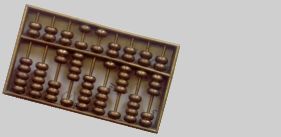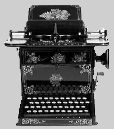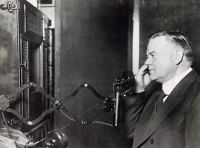|
1750 BC

The
decimal system is in use in Egypt.
500 BC
The
abacus
is invented by the Babylonians.
100-300 AD
The first
bound books are created in
Europe.
600 AD
The first
use of the zero
(as an actual value, as opposed to a place-holder) appears in
India.

1455
The
printing press, with movable
metal type, is invented by Johannes Gutenberg.
1600
The
term "electricity" is first
coined by English scientist William Gilbert.
1831
The
electric telegraph is invented
by Samuel Morse.
1844
The first
telegraphic message is sent
by Samuel Morse on May 24th from Washington to Baltimore. The
message reads, “What hath God wrought?”

1843
The first
fax machine is patented by
Alexander Bain.
1848
Boolean Algebra is invented by
British Mathematician George Boole. By representing logical expressions
in a mathematical form, Boole paves the way for the development of the
binary computer.
1861
The
Pony Express mail delivery
service begins in the United States.
1867
The first
commercial typewriter is
invented by Christopher Sholes, Carlos Glidden, and Samual Soule.
1876
The
electric telephone is patented
by Alexander Graham Bell.
1877
The
phonograph is patented by
Thomas Edison.
1889
The
automatic telephone exchange
(which in turn enables direct-dial telephones) is patented by Almon
Strowger.
1898
The first
telephone answering machines
appear.
1899
The first
magnetic recordings are
performed by Valdemar Poulsen, using magnetized steel tape as recording
medium, providing the foundation for mass data storage.
Quote of the Year: "Everything that can be
invented has already been invented."
–Charles H. Duell, director of the U.S. Patent
Office
1902
The first
transatlantic radio signals
are sent by Guglielmo Marconi from Cornwall to Newfoundland.

1927
The first U.S.
demonstration of
television
takes place on April 7, 1927, as the voice
and image of Secretary of Commerce Herbert Hoover, is transmitted over
telephone lines from Washington, D.C., to New York City to a group of
newspaper reporters and dignitaries gathered in the auditorium of AT&T
Bell Telephone Laboratories.
Quote of the Year: “Today we have, in a
sense, the transmission of sight for the first time in the world’s
history. Human genius has now destroyed the impediment of distance in a
new respect, and in a manner hitherto unknown.”
–Herbert Hoover, Secretary of Commerce
1935
The first
usable magnetic recording tape
is invented in Germany by researchers at BASF, using strips of
cellulose-acetylene (invented in 1932) instead of paper.
1938
Claude E.
Shannon's Master's thesis describes how Boolean Logic (a system based on
the concepts of AND, OR and NOT) can be used to represent the functions of
switches in digital electronic circuit. The concept is the basis of all
digital electronic design
today.
NEXT SECTION
GO TO:
Introduction
PART
I: The Dark Ages: When Time Stood Still
PART
II: Dawn of the Computer Age
PART
III: Dawn of the Internet
PART
IV: The Rise of (and Battle Over) the MP3
PART
V: Life After Napster
|